Day 3 of a 3 day long weekend of Early Winter tours today, our last day. It was a lovely day, dawning sunny and clear and remaining so through most of the day. A great day to be out on the coast.
We met in Wells. As we got into the car, a Red Kite circled lazily over the harbour, flushing all the Brent Geese which were feeding out on the saltmarsh. On our way west along the coast road, we stopped to look at some geese in a winter wheat field. As well as a large number of Greylags, there were also several Pink-footed Geese, smaller and with a darker head and bill, plus a couple of Egyptian Geese and a family of Brent Geese.
 Red Kite – circled over Wells Harbour this morning
Red Kite – circled over Wells Harbour this morning
Titchwell was our destination for the morning. The overflow car park was still quiet, so we decided to have a quick look to see what was in there. A couple of Bramblings were calling wheezily from the bushes, but flew off as we tried to walk round to see them. Two Greenfinch flew out of the hedge as well. Round at the visitor centre, we found one Brambling which was on the feeders briefly before dropping down to feed on the ground below. A Chaffinch nearby was suffering badly from the papilloma virus, with its legs and feet covered in growths.
As we walked out onto the reserve, we stopped to scan the Thornham grazing marsh. There was a large flock of Pink-footed Geese loafing down in the grass. Over at the back we spotted two Common Buzzards, one on a fencepost and one on the top of a large hawthorn, enjoying the morning sun. A male Stonechat was perching in the tops of the tall vegetation at the front, periodically dropping down to the ground.
As we walked up to the dried up ‘pool’ on the Thornham side, a Marsh Harrier was quartering over the reeds. A Grey Heron was standing in the sunshine in front of the reeds in the far corner. A Water Rail called from deep in the reeds down at the front, sounding a little like a squealing pig.
Scanning the mud, we picked up a Water Pipit on the edge of the vegetation right at the back. Its white underparts really stood out in the morning light. While we were watching it, two more Water Pipits flew in calling. One landed out in the open, much closer to us, and we got it in the scope briefly before it flew down to the front behind the reeds. As well as the whiter ground colour to the underparts, we could see the more obvious pale supercilium than the Rock Pipit we had been watching on Friday. A little further on, a Chinese Water Deer was feeding out on the saltmarsh.
With the high water levels on the freshmarsh at the moment, we were intending to walk straight past Island Hide but as we were alongside we heard another Water Rail down in the vegetation near the bridge. As we walked down towards the hide to look for it, it scurried out under the trees and disappeared into the reeds beyond. We could still hear it calling further back and with our best Water Rail impression, we were able to coax it back towards us and out onto the mud in amongst the sallow roots. Another two Water Rails then started duetting in the vegetation just beyond. While we were trying to see the Water Rail, we could hear Bearded Tits calling from out in the main reedbed.
We stopped on the bank just past Island Hide to scan the freshmarsh. The ducks seem to appreciate the high water levels. There were lots of Teal, mostly asleep but a few were feeding just below us. The adult drakes are now mostly out of eclipse and looking very smart again. A few Wigeon were grazing on the bits of the islands that weren’t under water. In amongst them, we could see a few Gadwall and Mallard and a little group of Shoveler were swimming around further back. Little groups of Brent Geese kept flying in and out from the saltmarsh.
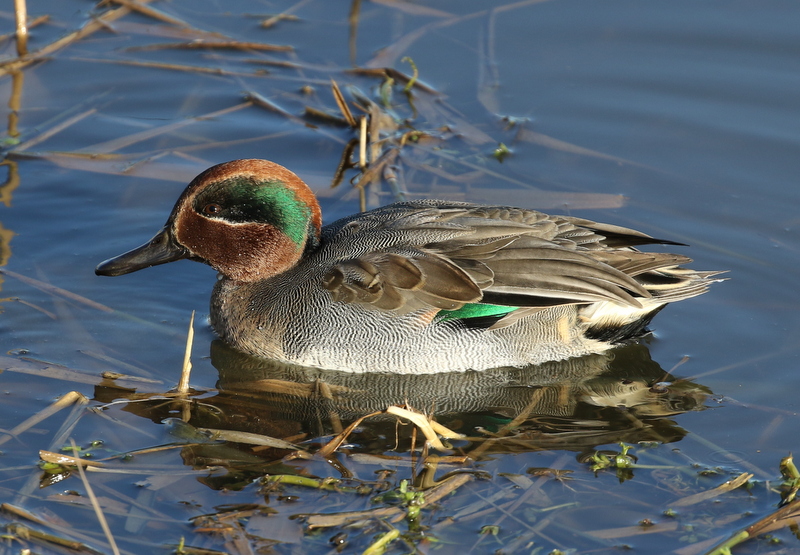 Teal – there are lots on the freshmarsh
Teal – there are lots on the freshmarsh
There are not so many waders on here now. Most of the Avocets have left for milder climes, but nine were still here today, sleeping in a little huddle. There are more Ruff, with a good number still around the remaining islands. It was hard to know how many Dunlin there were, as they were scattered around and running in and out of the taller vegetation. In with them, we found a single Ringed Plover. A small flock of Golden Plover flew in, whirled round over the water and flew off again inland.
 Avocets – still nine on the freshmarsh today
Avocets – still nine on the freshmarsh today
There were not so many gulls on the freshmarsh on the walk out this morning. We did quickly locate a single adult Yellow-legged Gull. It was sitting on the water, so we couldn’t see its yellow legs, but we could see its darker grey mantle and relatively unstreaked white head.
 Yellow-legged Gull – this adult was loafing around on the freshmarsh all day
Yellow-legged Gull – this adult was loafing around on the freshmarsh all day
Outside Parrinder hide, we stopped to talk to a couple of locals who were standing with their scopes pointed back along the edge of the freshmarsh. It turned out that a Jack Snipe had been seen earlier but had disappeared some time ago in towards the bank, behind the reeds. Our timing was spot on because, while we were talking to them, someone spotted it come back out onto the island.
We watched the Jack Snipe through the scope for a few minutes while it worked its way back along the edge of the island. Unusually, it wasn’t bouncing much today – the distinctive feeding Jack Snipe action. Then suddenly and for no apparent reason it flew off, over the main path, and dropped down out of view onto the saltmarsh beyond. There were also two Common Snipe asleep on the island, so we had a look at those too, noting in particular the pale central crown stripe which Jack Snipe lacks.
 Jack Snipe – feeding on the island from Parrinder Hide
Jack Snipe – feeding on the island from Parrinder Hide
From inside Parrinder Hide, we could see two more Common Snipe feeding along the bank out of the right hand side. The reeds have been cut back here, giving them fewer places to hide and they were much closer than the ones we had just been looking at. They gave great views as they probed in the wet grass along the edge of the freshmarsh.
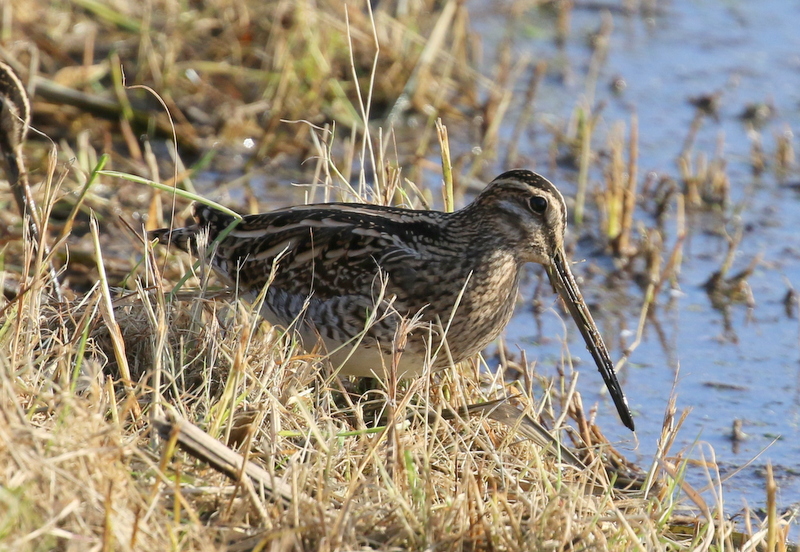 Common Snipe – two were feeding just outside Parrinder Hide
Common Snipe – two were feeding just outside Parrinder Hide
While we were watching the Common Snipe, we happened to look a little further back along the water’s edge and noticed a Water Pipit working its way towards us. It was picking around in the cut reeds.We hadn’t seen or heard it fly in, and apparently one had been here earlier, so it is possible this was a different bird to the three we had seen on the Thornham grazing marsh pool. It certainly seemed more heavily marked below than the two we had managed to get in the scope.
This was an even better view than the closer Water Pipit we had seen earlier, on our walk out. It looked like it might come all the way to the hide at one point, but turned and started to work its way back away from us again.
 Water Pipit – possibly our fourth today, from Parrinder Hide
Water Pipit – possibly our fourth today, from Parrinder Hide
There didn’t look to be a lot on the Volunteer Marsh, so we started out to walk towards the beach. As we were back on the main path, we stopped to look at a single Black-tailed Godwit on the mud. Just at that moment, all the waders scattered, flying off in different directions. We looked up to see a stunning adult Peregrine which flew across the path right in front of us. The light was perfect and we could see all the plumage details,but unfortunately cameras were not at the ready! It dropped away over the saltmarsh and turned, powering low out towards the beach.
As we walked towards the tidal pools, we could hear a Kingfisher calling. When we got over the bank, a quick scan back along the bushes revealed it perched distantly in the far corner. Still we had a look at it through the scope, shining bright blue in the morning sun. There are always Little Grebes on here during the winter, and today was no exception. We counted seven, with two diving just below the main path. Two female Pintail were upending out in the middle.
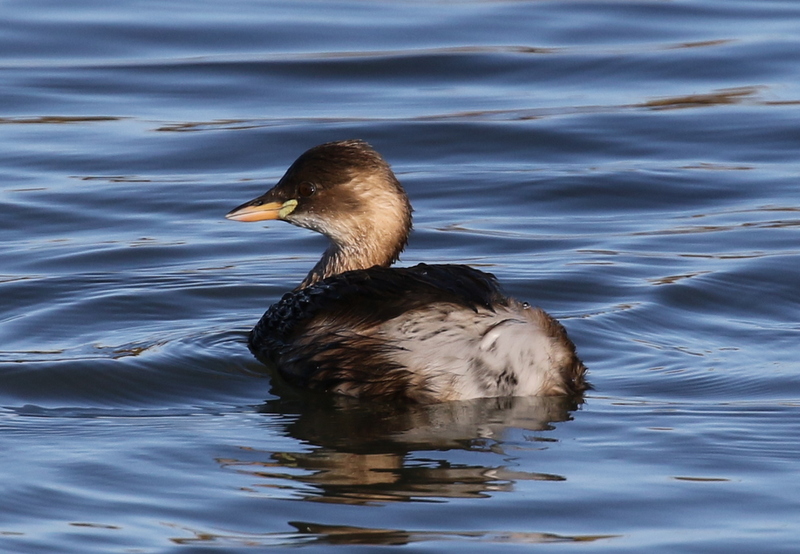 Little Grebe – one of the seven we counted on the tidal pools
Little Grebe – one of the seven we counted on the tidal pools
Out at the beach, the tide was out. As we arrived, all the waders on the mussel beds were flushed by people walking along the shoreline. There were lots of Oystercatchers, several Grey Plover and a good sized flock of Knot. They landed again a little further over towards Brancaster. Once we had walked down the beach a little, they started to drift back again. We picked up several godwits, both Bar-tailed Godwit and Black-tailed Godwit. A few silvery grey Sanderlings were running up and down on the edge of the sea.
There were several small parties of Common Scoter on the sea, the majority of them pale-cheeked brown females. A single adult drake was closer in, just behind the breakers, and we had a good look at it in the scope. We could even see the yellow stripe down the front of its bill. A Guillemot was diving in the surf too and a couple of Great Crested Grebes drifted past. A single Red-breasted Merganser flew across and a distant juvenile Gannet made its way slowly east.
Back at the tidal pools, the Kingfisher had come much closer. It was perched in the vegetation on the edge of the small island nearest the beach, a much better view than we had on the walk out. There were also a few more waders roosting on the spit, including a Black-tailed Godwit and a Bar-tailed Godwit side by side, giving us a great opportunity to compare the two species.
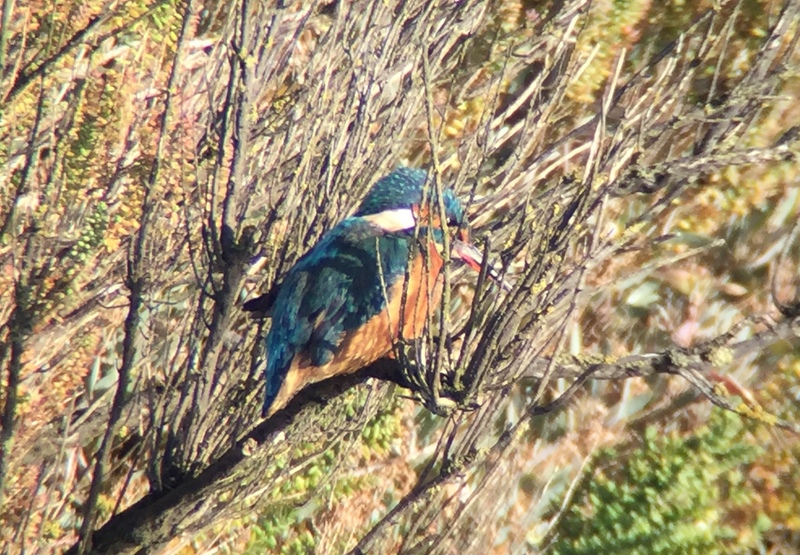 Kingfisher – gave better views on the tidal pools on the walk back
Kingfisher – gave better views on the tidal pools on the walk back
After lunch back at the car, we drove over to Holme. A quick chat with one of the wardens who happened to be driving past suggested there may still be a Waxwing present (there had been several here earlier in the week). We had a walk round behind the paddocks but there was no sign of it. Several Blackbirds and Redwings were enjoying the hawthorn berries though, and a few Greenfinches. A couple of Mistle Thrushes landed briefly before flying off over the saltmarsh.
Coming back along Broadwater Road, we took a little detour out towards Redwell Marsh. Several skeins of Pink-footed Geese appeared to come up from the grazing marshes to the east and flew off towards the Wash. We could hear a flock of Long-tailed Tits in the bushes down by the river, and looked up to see a late Chiffchaff flitting around in the trees.
 Pink-footed Geese – flying off towards the Wash
Pink-footed Geese – flying off towards the Wash
Our final stop of the day was at Thornham Harbour. We had hoped to catch up with some Twite here, but they seem to be rather elusive at the moment and there was no sign of them. As we walked out along the seawall towards Holme, we did have four Lapland Buntings which flew over calling.
As we walked up towards the boardwalk overlooking Broadwater, we could hear more Water Rails squealing. A young Sparrowhawk sent a flock of Starlings scattering, before landing on a fence post. A covey of Grey Partridge exploded from the edge of the saltmarsh as we passed. On the Broadwater itself, there were lots of Gadwall and Coot, along with three Tufted Ducks.
As we walked back, the tide was coming in fast. There were loads of gulls gathered out on the mud, being pushed in by the rising water. We could hear Greenshanks calling and eventually spotted them when they were forced out from where they were hiding on the saltmarsh and flew up and down looking for somewhere dry to land.
Tomorrow night is full moon, and it is also going to be a ‘supermoon’. More properly known as perigee-syzygy, this is when the full moon is at its closest point to the Earth, and it appears bigger and brighter than normal. Tonight was almost a full moon and only a fraction smaller (the closest approach is actually at 11.23am tomorrow morning!).
It was a fairly clear evening, so we were treated to a stunning ‘supermoon’ rise as we got back to the car. Flocks of Pink-footed Geese flying across the saltmarsh in front of us, calling, only added to the atmosphere. It was a great way to end our three days birding.
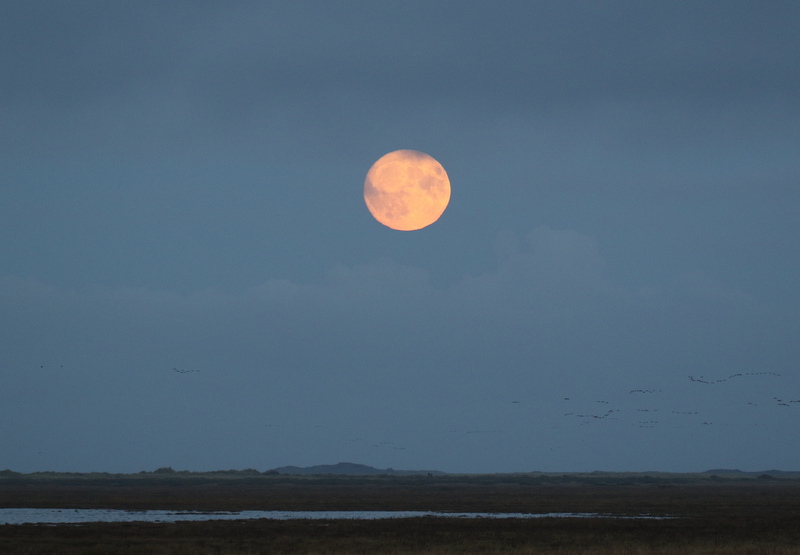 Supermoon – rising over Thornham Harbour
Supermoon – rising over Thornham Harbour
















